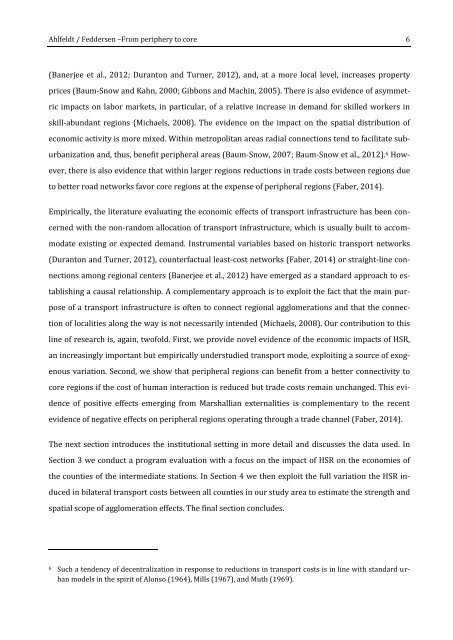sercdp0172
sercdp0172
sercdp0172
Create successful ePaper yourself
Turn your PDF publications into a flip-book with our unique Google optimized e-Paper software.
Ahlfeldt / Feddersen –From periphery to core 6(Banerjee et al., 2012; Duranton and Turner, 2012), and, at a more local level, increases propertyprices (Baum-Snow and Kahn, 2000; Gibbons and Machin, 2005). There is also evidence of asymmetricimpacts on labor markets, in particular, of a relative increase in demand for skilled workers inskill-abundant regions (Michaels, 2008). The evidence on the impact on the spatial distribution ofeconomic activity is more mixed. Within metropolitan areas radial connections tend to facilitate suburbanizationand, thus, benefit peripheral areas (Baum-Snow, 2007; Baum-Snow et al., 2012). 6 However,there is also evidence that within larger regions reductions in trade costs between regions dueto better road networks favor core regions at the expense of peripheral regions (Faber, 2014).Empirically, the literature evaluating the economic effects of transport infrastructure has been concernedwith the non-random allocation of transport infrastructure, which is usually built to accommodateexisting or expected demand. Instrumental variables based on historic transport networks(Duranton and Turner, 2012), counterfactual least-cost networks (Faber, 2014) or straight-line connectionsamong regional centers (Banerjee et al., 2012) have emerged as a standard approach to establishinga causal relationship. A complementary approach is to exploit the fact that the main purposeof a transport infrastructure is often to connect regional agglomerations and that the connectionof localities along the way is not necessarily intended (Michaels, 2008). Our contribution to thisline of research is, again, twofold. First, we provide novel evidence of the economic impacts of HSR,an increasingly important but empirically understudied transport mode, exploiting a source of exogenousvariation. Second, we show that peripheral regions can benefit from a better connectivity tocore regions if the cost of human interaction is reduced but trade costs remain unchanged. This evidenceof positive effects emerging from Marshallian externalities is complementary to the recentevidence of negative effects on peripheral regions operating through a trade channel (Faber, 2014).The next section introduces the institutional setting in more detail and discusses the data used. InSection 3 we conduct a program evaluation with a focus on the impact of HSR on the economies ofthe counties of the intermediate stations. In Section 4 we then exploit the full variation the HSR inducedin bilateral transport costs between all counties in our study area to estimate the strength andspatial scope of agglomeration effects. The final section concludes.6 Such a tendency of decentralization in response to reductions in transport costs is in line with standard urbanmodels in the spirit of Alonso (1964), Mills (1967), and Muth (1969).


